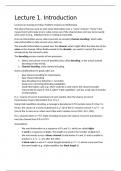College aantekeningen
College aantekeningen Coding & Cryptography (X_405041)
Uitgebreide aantekeningen van alle hoorcolleges van het vak Coding and Cryptography, dat wordt gegeven op de Vrije Universiteit (VU) aan de master 'Computer Science'.
[Meer zien]




